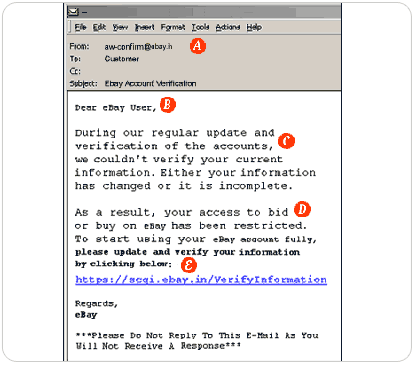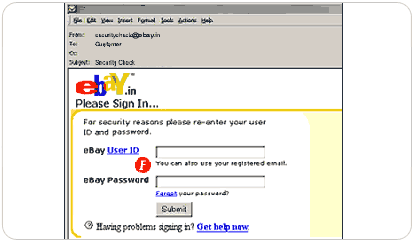Spoof emails are emails that fake the appearance of a popular Web
site or company in an attempt to commit identity theft. These emails
claim to be sent by well-known companies and ask consumers to reply
with personal information, such as their credit card number, banking
details or account password.


| Identifying a Spoof email? |
 |
 |
A. Sender's Email Address
Spoof email may include a forged email address in the "From" line
- Some may actually be real email addresses that have been forged.
(From: billing@ebay.com; From: eBayAcctMaintenance@eBay.com; From:
support@ebay.com).
B. Email Greeting
Many Spoof emails will begin with a general greeting such as "Welcome
eBay User", and not with the actual registered id.
C. Urgency
Claims that eBay is updating its files or accounts. It is highly
unlikely that eBay will ever lose your account information.
D. Account Status Threat
Most Spoof emails try to deceive you with the threat that your account
is at risk and you will not be able to buy or sell on eBay if you
do not update it immediately.
E. Links in an Email
While many emails have links included, just remember that these
links can be forged too.
F. Requests Personal Information
Any emails that request you to enter sensitive personal information
such as a User ID, password or bank account number by clicking on
a link or completing a form within the email are a clear indicator
of a Spoof email
Spoof Emails and Spoof Websites
A spoof email will also lead you to a spoof website. Ensure to check
the web address (URL) of the website the email directs you to.
To determine if the Web address in your browser is a real eBay
address, look for ".ebay.in" immediately before the first "/".
The following examples notice that there must be a "." before eBay.in
or eBay.com for the address to be legitimate.
Examples
of real addresses:
http://cgi3.ebay.in/
http://arribada.ebay.in/ |
Examples
of fake addresses:
http://signin.ebay.in@10.19.32.4/
http://signin-ebay.in/ |
Did you know?
You should never click on a link in an email if you are unsure
of its origins, especially if the email asks for personal financial
information. |
Report a Spoof email
You can choose to simply ignore a spoof email. Never provide sensitive
contact information, passwords, financial information in an email.
Report the email for us to take action.
If you have any doubt whether an email is really from eBay, here's
how to report it:
1. Forward the message to spoof@ebay.com
2. Don't alter the subject line or forward the message as an attachment
- doing so prevents us from investigating it further.
3. Once you have forwarded the email, you can then delete it from
your email account.
Tips to protect your online accounts
Periodically check your account status to see if there is any
suspicious activity.
- Change Your Password frequently
- Make Your Password Unique. A good password will include a
combination of letters and numbers - this makes it more difficult
for people to guess the password. |